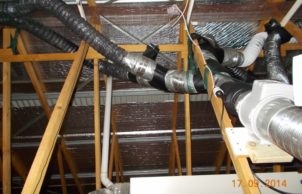Alan and Bev’s House
Alan and Bev’s House
A typical four bedroom brick-veneer home – now 13 years old. A non-ideal East-West orientation. Large 1100 squ. metre block. Retrofit of many ‘sustainable’ features over last 3 years with the aim DIY and LOW COST. These features include:
—- Supplementary Winter heating (cold Winter climate in Wagga Wagga) utilising daytime heat build-up in roof cavity. This is achieved, using a closed loop system, by ducting room air along the peak of the roof cavity in order to return the same air at a significantly raised temperature back to various rooms in the house. The weekly cost to run the necessary in-line fan is less than $2 and overall cost was $750. An article on this system in my house was published in ReNew Magazine Issue 132.
—- DIY low cost double glazing using sheet acrylic. Working with my standard aluminium windows I achieved this for a cost under $1500 and no unsightly ‘spacers’ were needed (two sliding doors were not double glazed). I felt I had some fresh innovative ideas in carrying out this project and wrote an article on this, which was published in ReNew Magazine Issue 135.
—- I maximised roof rainwater collection into a 10,000 litre rainwater tank using a ‘wet’ system. Some innovation was needed in overcoming a minimal height difference between the bottom of the guttering and the top of the tank and a very long run along the side of the house to the tank down the back.
—- A productive, edible garden with about 18 raised beds, fruit trees and a very large bird-mesh covered berry house are mostly all drip watered from one line from the water tank. An aesthetic, edible garden with minimisation of previous lawn areas has been achieved.
—- In another article in ReNew Magazine (Issue 130) I detailed my approach to Summer shading (which I would show an example of on Open Day), downlight modifications (change to LED, increase ceiling insulation around downlights using mitts), DraftStoppas over bathroom ceiling fans, preventing Winter heat loss through evaporative cooler vents and cheap but effective window pelmets.
—- backyard chickens to provide eggs and to assist in composting systems.
—-








Ask questions about this house
Load More Comments